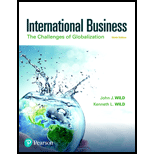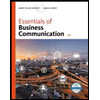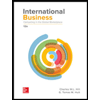
To Explain:
Reason as to why these companies may have gone wrong in their analyses.
Introduction:
The globalization has completely changed the way businesses were being conducted throughout the world. Globalization comes with lots of advantages and obviously with some disadvantages as well. In the hurry of expansion, companies do some mistakes in their analysis. The analytical mistakes affected the companies badly.
Explanation of Solution
After globalization, international businesses flourished. Many Western Companies flooded into China. It allowed them to compete for market share in all sorts of businesses. After this, several small and local companies scaled back their operation or left China completely.
It is true some countries have cultural similarities despite differences in language, attitude toward business, religion, traditions, customs and many other factors. The successful product in one market is sold to other markets without or less modification. But many products should undergo extensive adaptation to suit the local tastes like books, magazines, ready-to-eat meals, and others.
Let’s see Coca-Cola’s example in China. Many people use traditional medicine as cough syrup during flu. The taste of the syrup is not appealing for people there and its taste is similar to Coca-Cola. Since Coca-Cola has a policy of one taste worldwide, the company had to face aversion to taste among Chinese people and the company lost its market there. So, the cultural elements can affect site decisions.
The company might choose to set up production facilities in the target market. The above loss for Coca-Cola Company can be minimized by flexible manufacturing methods. The productive operations can be strengthened by a strong work ethic among the local workforce. An adequate level of education in locals is very important for planned business activities. These are crucial for site consideration in a different county.
Want to see more full solutions like this?
Chapter 12 Solutions
Pearson eText International Business: The Challenges of Globalization -- Instant Access (Pearson+)
- Even before you launch your business, you have to be ready to handle the funds that will flow in and out as you buy raw materials, pay rent, receive customer payments, and reserve cash to pay taxes. Which financial services should you have in place on your first day in business? Which might be needed months later, after you’ve established your business? Write two to three sentences about your company’s need for financial services, now and during the first year.arrow_forwardCalculate the gross profit ratio based on the given details:arrow_forwardaccounting questionarrow_forward
- During 2022, Hunter Enterprises generated revenues of $175,000. The company's expenses were as follows: cost of goods sold of $92,000, operating expenses of $32,000, and a loss on disposal of assets of $5,000. Hunter's gross profit is_.arrow_forwardBaxter Ceramics uses the number of minutes in its heating kiln to allocate overhead costs to products. In a typical month, 7,400 kiln minutes are expected, and the average monthly overhead costs are $4,810. During March, 7,000 kiln minutes were used, and total overhead costs were $4,350. Required: Compute Baxter's predetermined overhead rate and the amount of applied overhead for March. Round your answers to the nearest cent.arrow_forwardCan you help me solve this general accounting problem with the correct methodology?arrow_forward
- A company identifies two activities: material handling and machine setup. The cost drivers are number of parts (10,000) and number of setups (200), with cost pools of $250,000 and $180,000 respectively. Product A uses 2,500 parts and 50 setups. Calculate the activity-based overhead allocated to Product A.arrow_forwardPlease explain the solution to this general accounting problem using the correct accounting principles.arrow_forwardHello tutor! Solve this question. Subject = General Business. Correct answer otherwise i will give unhelpful.arrow_forward
 BUSN 11 Introduction to Business Student EditionBusinessISBN:9781337407137Author:KellyPublisher:Cengage Learning
BUSN 11 Introduction to Business Student EditionBusinessISBN:9781337407137Author:KellyPublisher:Cengage Learning Essentials of Business Communication (MindTap Cou...BusinessISBN:9781337386494Author:Mary Ellen Guffey, Dana LoewyPublisher:Cengage Learning
Essentials of Business Communication (MindTap Cou...BusinessISBN:9781337386494Author:Mary Ellen Guffey, Dana LoewyPublisher:Cengage Learning Accounting Information Systems (14th Edition)BusinessISBN:9780134474021Author:Marshall B. Romney, Paul J. SteinbartPublisher:PEARSON
Accounting Information Systems (14th Edition)BusinessISBN:9780134474021Author:Marshall B. Romney, Paul J. SteinbartPublisher:PEARSON
 International Business: Competing in the Global M...BusinessISBN:9781259929441Author:Charles W. L. Hill Dr, G. Tomas M. HultPublisher:McGraw-Hill Education
International Business: Competing in the Global M...BusinessISBN:9781259929441Author:Charles W. L. Hill Dr, G. Tomas M. HultPublisher:McGraw-Hill Education





